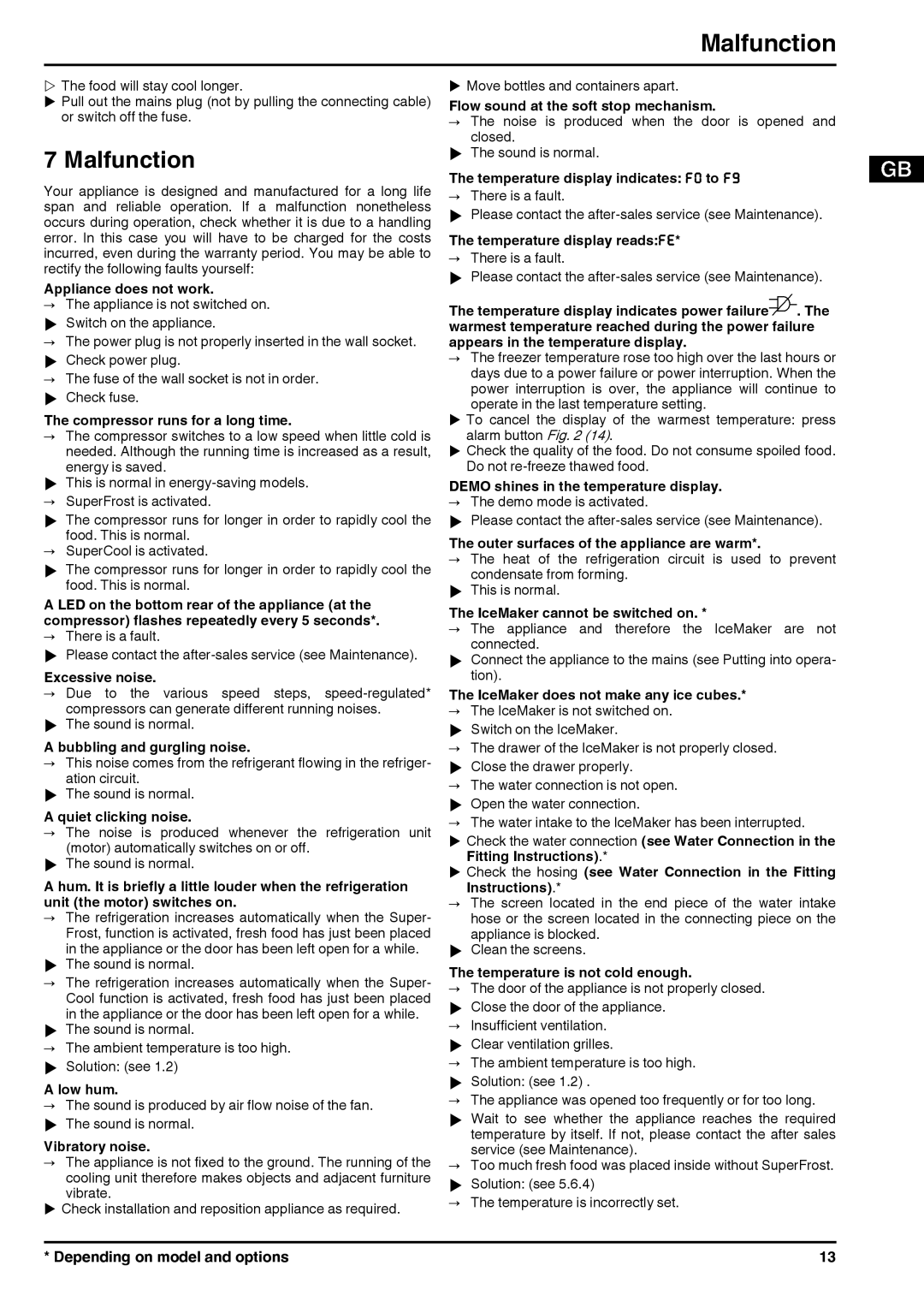w The food will stay cool longer.
u Pull out the mains plug (not by pulling the connecting cable) or switch off the fuse.
7 Malfunction
Your appliance is designed and manufactured for a long life span and reliable operation. If a malfunction nonetheless occurs during operation, check whether it is due to a handling error. In this case you will have to be charged for the costs incurred, even during the warranty period. You may be able to rectify the following faults yourself:
Appliance does not work. |
→ | The appliance is not switched on. |
u | Switch on the appliance. |
→ | The power plug is not properly inserted in the wall socket. |
u | Check power plug. |
→ | The fuse of the wall socket is not in order. |
uCheck fuse.
The compressor runs for a long time.
→ The compressor switches to a low speed when little cold is needed. Although the running time is increased as a result, energy is saved.
u This is normal in energy-saving models. → SuperFrost is activated.
u The compressor runs for longer in order to rapidly cool the food. This is normal.
→ SuperCool is activated.
uThe compressor runs for longer in order to rapidly cool the food. This is normal.
A LED on the bottom rear of the appliance (at the compressor) flashes repeatedly every 5 seconds*. → There is a fault.
uPlease contact the after-sales service (see Maintenance).
Excessive noise.
→ Due to the various speed steps, speed-regulated* compressors can generate different running noises.
u The sound is normal.
A bubbling and gurgling noise.
→ This noise comes from the refrigerant flowing in the refriger- ation circuit.
u The sound is normal.
A quiet clicking noise.
→ The noise is produced whenever the refrigeration unit (motor) automatically switches on or off.
u The sound is normal.
A hum. It is briefly a little louder when the refrigeration unit (the motor) switches on.
→ The refrigeration increases automatically when the Super- Frost, function is activated, fresh food has just been placed in the appliance or the door has been left open for a while.
u The sound is normal.
→ The refrigeration increases automatically when the Super- Cool function is activated, fresh food has just been placed in the appliance or the door has been left open for a while.
u The sound is normal.
→ The ambient temperature is too high. u Solution: (see 1.2)
A low hum.
→ The sound is produced by air flow noise of the fan. u The sound is normal.
Vibratory noise.
→ The appliance is not fixed to the ground. The running of the cooling unit therefore makes objects and adjacent furniture vibrate.
u Check installation and reposition appliance as required.
uMove bottles and containers apart.
Flow sound at the soft stop mechanism.
→ The noise is produced when the door is opened and closed.
u The sound is normal.
The temperature display indicates: F0 to F9
→There is a fault.
uPlease contact the after-sales service (see Maintenance).
The temperature display reads:FE*
→There is a fault.
uPlease contact the after-sales service (see Maintenance).
The temperature display indicates power failure . The
warmest temperature reached during the power failure appears in the temperature display.
→ The freezer temperature rose too high over the last hours or days due to a power failure or power interruption. When the power interruption is over, the appliance will continue to operate in the last temperature setting.
u To cancel the display of the warmest temperature: press alarm button Fig. 2 (14).
u Check the quality of the food. Do not consume spoiled food. Do not re-freeze thawed food.
DEMO shines in the temperature display. → The demo mode is activated.
uPlease contact the after-sales service (see Maintenance).
The outer surfaces of the appliance are warm*.
→ The heat of the refrigeration circuit is used to prevent condensate from forming.
u This is normal.
The IceMaker cannot be switched on. *
→ The appliance and therefore the IceMaker are not connected.
u Connect the appliance to the mains (see Putting into opera- tion).
The IceMaker does not make any ice cubes.* |
→ | The IceMaker is not switched on. |
u | Switch on the IceMaker. |
→ | The drawer of the IceMaker is not properly closed. |
u | Close the drawer properly. |
→ | The water connection is not open. |
u | Open the water connection. |
→ | The water intake to the IceMaker has been interrupted. |
u Check the water connection (see Water Connection in the |
| Fitting Instructions).* |
u Check the hosing (see Water Connection in the Fitting |
→ | Instructions).* |
The screen located in the end piece of the water intake |
| hose or the screen located in the connecting piece on the |
| appliance is blocked. |
u Clean the screens. |
The temperature is not cold enough. |
→ | The door of the appliance is not properly closed. |
u | Close the door of the appliance. |
→ | Insufficient ventilation. |
u | Clear ventilation grilles. |
→ | The ambient temperature is too high. |
u | Solution: (see 1.2) . |
→ | The appliance was opened too frequently or for too long. |
u | Wait to see whether the appliance reaches the required |
| temperature by itself. If not, please contact the after sales |
| service (see Maintenance). |
→ Too much fresh food was placed inside without SuperFrost. |
u | Solution: (see 5.6.4) |
→ | The temperature is incorrectly set. |

